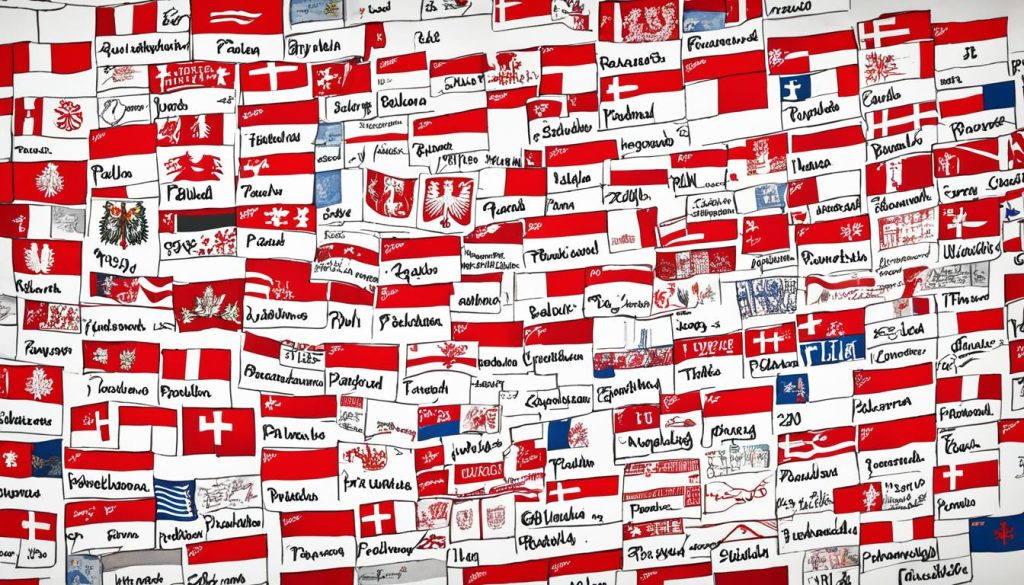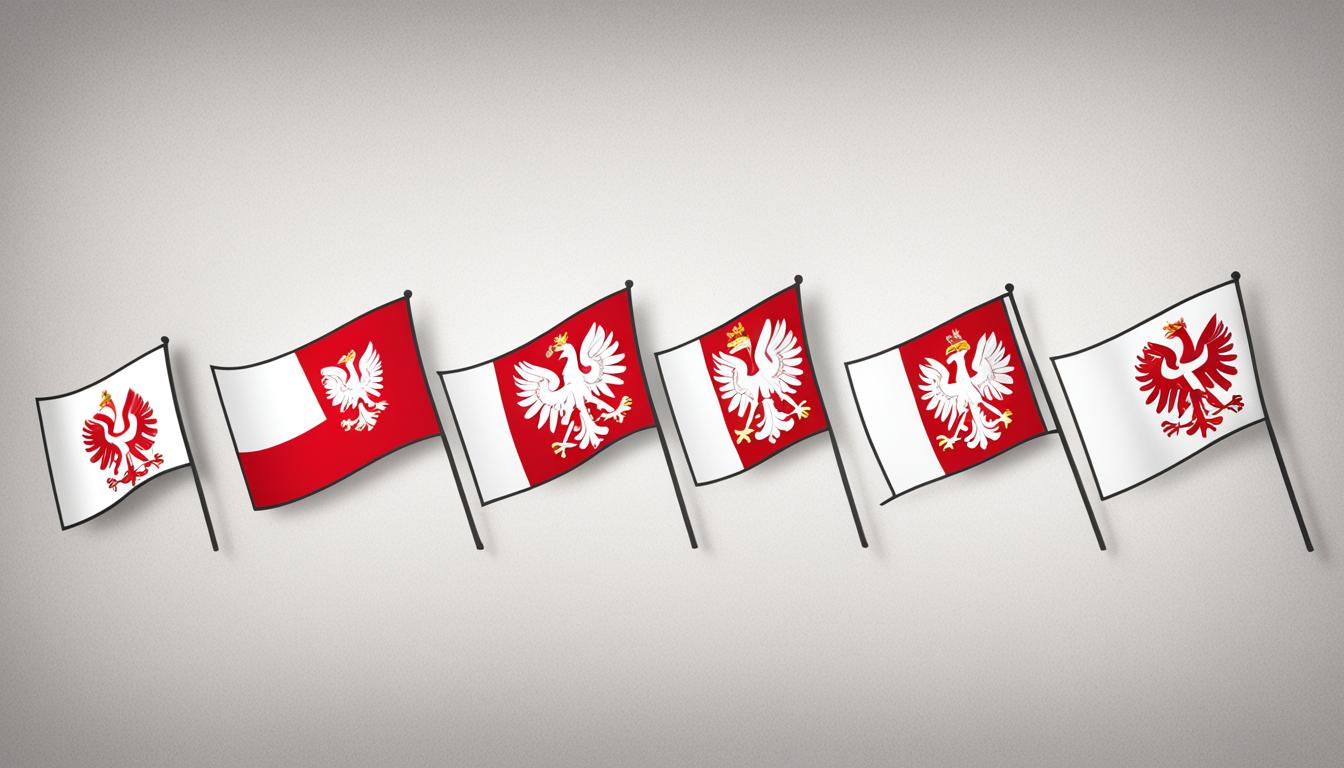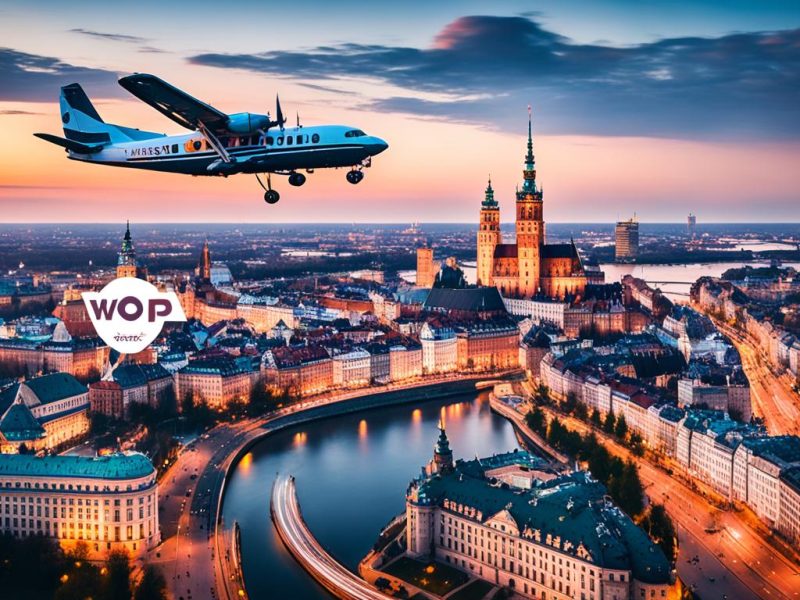The Polish flag is more than just colours on a fabric. It represents the country’s deep roots and identity. Its history is filled with stories of resilience and a strong desire for freedom. Through this flag, we see the journey and pride of the Polish people.
Key Takeaways
- Poland’s flag represents its complex past and enduring sovereign status.
- The white and red emblem signifies national unity and a resilient spirit.
- Understanding the flag’s history enhances its emblem significance.
- Each aspect of the flag reflects deep cultural values and collective memories.
- Polish flag history is a testament to the nation’s journey through geopolitical upheavals.
The Origins of the Poland Flag
The colours white and red symbolise Poland’s freedom and unity. Looking back at the Polish flag origins takes us through a history filled with culture and pride. The journey from Poland’s ancient emblems to its legal national symbols shows the flag’s true meaning.
Early History and First Uses
In medieval times, banners and colours started representing nations. The historical flags of Poland came from the Piast dynasty symbols. These symbols linked the flag to the nation’s pride and identity.

Evolution of Design through the Centuries
The flag’s design changed with history and politics. Monarchy times saw the eagle on the flag. Uprisings and government changes also influenced the design. Each version tells a story of Poland’s history.
Legislation and Legal Aspects of the National Emblem
The Polish flag is protected by national symbols legislation. It’s more than a cloth; it’s a law-protected symbol. The 1980 Act outlines its use and how it should look. These laws keep the flag’s honour intact.
| Period | Description | Legal Act |
|---|---|---|
| Medieval Era | Flag linked to Piast dynasty heraldry | N/A |
| Commonwealth | Incorporation of the eagle symbol | N/A |
| 19th Century | Alterations influenced by uprisings | N/A |
| 1980 onwards | Standardisation and legal protection | 1980 Act on National Symbols |
Colours and Design of the Poland Flag
The Poland flag colours meaning goes beyond just looking nice. It carries deep national feelings. The flag has two horizontal bands in white and red. White represents peace and purity, while red symbolises courage and bravery. The Polish national emblem design, sometimes added to the flag, tells stories of Poland’s history and culture.
Looking closely at the flag shows how it reflects Poland’s national spirit. We see why specific colours were used. They show the heart of Polish history through their arrangement.
During important state events and sports, a special flag version is seen. It features a white eagle against a red shield. This national emblem is a sign of true Polish heritage. It reminds us of Poland’s historical symbols.
| Colour | Symbolism | Association |
|---|---|---|
| White | Peace and purity | National ethical values and moral clarity |
| Red | Courage and valour | The blood shed in the nation’s struggle for independence |
Studying the white and red flag, we notice its bands are equal. This design signifies balance and equality in Poland. The white strip often goes on top, especially on official buildings. It shows Poland values peace as much as it does bravery in conflict.
The Polish flag stands for the country’s dreams and its respected, age-old traditions. Its colours and proud emblem highlight Poland’s distinguished past.
Symbolic Meanings behind the Poland Flag
The Poland flag is more than national heraldry. It’s a deep symbol of white and red symbolism. For centuries, these colours have shown the Polish spirit and pride. The Polish flag interpretation tells a story of freedom, courage, and remembering sacrifices.
The white on the flag stands for peace and purity. It reflects a nation’s desire for harmony and moral direction. Red shows the courage and sacrifice in their fight for freedom. Together, these colours are a powerful reminder of national pride. They bring comfort and belonging to Poles everywhere.
- Purity and peace signified by white
- Red reflecting bravery and sacrifice
- A unifying banner for global Polish diaspora
- A symbol of historical and contemporary national resilience
The flag plays a big part in Poland’s national and cultural events. On Independence Day, it unites everyone under a single symbol of Polish spirit.
Every wave of the flag tells the story of Poland. It’s a story shared by all its people. The flag marks Poland’s past, present and hopes for the future.
Contemporary Use and International Recognition
In recent times, the Poland flag has grown to be a key symbol in Poland’s diplomacy. It shows Poland’s independence and culture to the world. This is especially true in places where nations come together to build and maintain friendly ties.
Poland Flag in Diplomacy and Global Events
At embassies, important meetings, and big summits, the Poland flag is often seen. It stands for the country and the interests of its people. This shows Poland’s active participation in world conversations and how the flag plays a role in diplomacy.
Respect and Protocols Associated with the Flag
There are strict rules around respecting the Poland flag, as with other national symbols. The way it’s raised and how people act during special events shows deep respect for this emblem. Every action taken with the flag underscores its importance.
Use in Sports and International Competitions
The Poland flag brings together athletes and supporters, sparking national pride. At the Olympics or football games, the flag’s presence is felt worldwide. It links the nation and its athletes in a powerful way.
| Event | Role of the Poland Flag | Protocols Observed |
|---|---|---|
| Diplomatic Meetings | Symbol of National Presence | Formal Display alongside other Nations |
| Cultural Festivals | Promotion of National Heritage | Respectful Handling during Parades |
| Sporting Events | Emblem of National Team Unity | National Anthem Composition, Flag Raising |
| International Summits | Representation of National Interests | Ceremonial Positioning for Visibility |
Conclusion
The Poland flag’s journey shows the nation’s strength and deep roots in history. This article highlights the flag’s role as a symbol of unity. That symbol brings Polish people together, both at home and worldwide. The red and white motif represents the nation’s spirit and identity shaped through time.
By understanding its history and design, we see the flag’s importance. It carries culture and tells stories of overcoming challenges. This makes the flag more than a symbol. It is a national treasure with deep significance.
The flag symbolises freedom and the ongoing fight for sovereignty as a national emblem of pride. Today, it remains important in national events, sports, and diplomacy. It is a symbol of solidarity and pride. Each time the flag is raised, it celebrates Polish identity and hopes.
The Poland flag tells a story of heritage, courage, and brotherhood. Its design speaks of resilience and revival, a symbol for all Poles. Over time, it remains a key part of Poland’s identity. It stands for freedom and patriotism, always.
FAQ
What does the Poland flag represent?
The Poland flag stands for the nation’s rich history and identity. It symbolizes Polish pride and togetherness. The flag reflects the people’s fight for freedom and their cultural importance.
How has the design of the Poland flag evolved over time?
The Poland flag’s design has changed many times, mirroring societal and political changes. Its evolution is rooted in early history. It’s also shaped by laws about how it should be shown.
What is the significance of the colours on the Poland flag?
The colours white and red on the Poland flag are full of meaning. White represents peace and truth. Red stands for courage and strength. Together, these colours show the Polish nation’s values and heritage.
Are there any laws regulating the use of the Poland flag?
Yes, there are laws that govern how the Poland flag should be used and shown. These ensure the flag is treated with respect. They set rules for its proper display and handling.
When is the national coat of arms included on the Poland flag?
The national coat of arms appears on certain versions of the Poland flag. This is mainly for official government use. It’s seen at global events, diplomatic meetings, and by top officials.
How does the Poland flag feature in international sporting events?
At international sports events, the Poland flag unites the national team and fans. It symbolizes the country and its athletes. Celebrating Polish national identity and pride on the world stage.
What protocols must be followed when displaying the Poland flag?
Specific protocols exist for showing the Poland flag with respect. This includes handling it properly and placing it correctly. The flag must be visible and in fine condition during public and official displays.
How does the flag of Poland foster a sense of national pride?
The Poland flag boosts national pride by showing the nation’s story, achievements, and challenges. It reminds people of ancestral sacrifices. It stands for the Polish spirit and unity.



